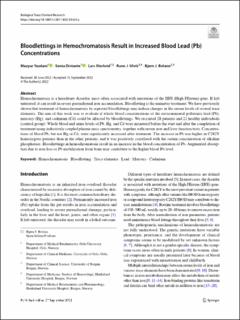Bloodlettings in Hemochromatosis Result in Increased Blood Lead (Pb) Concentrations
Journal article, Peer reviewed
Published version

Åpne
Permanent lenke
https://hdl.handle.net/11250/3044237Utgivelsesdato
2022Metadata
Vis full innførselSamlinger
- Department of Clinical Science [2295]
- Registrations from Cristin [9489]
Sammendrag
Hemochromatosis is a hereditary disorder, most often associated with mutations of the HFE (High FErrum) gene. If left untreated, it can result in severe parenchymal iron accumulation. Bloodletting is the mainstay treatment. We have previously shown that treatment of hemochromatosis by repeated bloodlettings may induce changes in the serum levels of several trace elements. The aim of this work was to evaluate if whole blood concentrations of the environmental pollutants lead (Pb), mercury (Hg), and cadmium (Cd) could be affected by bloodlettings. We recruited 28 patients and 21 healthy individuals (control group). Whole blood and urine levels of Pb, Hg, and Cd were measured before the start and after the completion of treatment using inductively coupled plasma mass spectrometry, together with serum iron and liver function tests. Concentrations of blood Pb, but not Hg or Cd, were significantly increased after treatment. The increase in Pb was higher in C282Y homozygous patients than in the other patients, and it was positively correlated with the serum concentration of alkaline phosphatase. Bloodlettings in hemochromatosis result in an increase in the blood concentration of Pb. Augmented absorption due to iron loss or Pb mobilization from bone may contribute to the higher blood Pb level.
